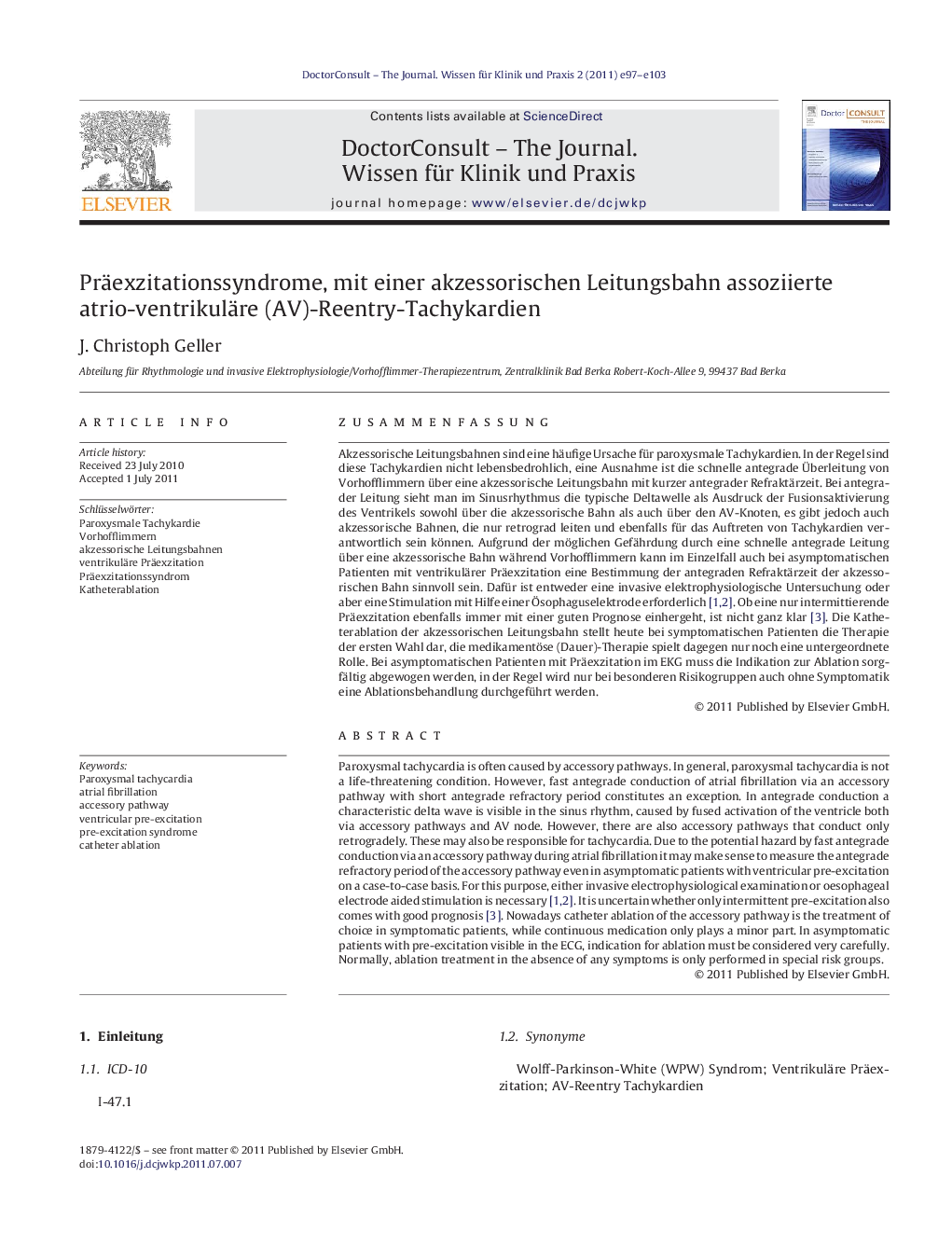| کد مقاله | کد نشریه | سال انتشار | مقاله انگلیسی | نسخه تمام متن |
|---|---|---|---|---|
| 3464879 | 1232440 | 2011 | 7 صفحه PDF | دانلود رایگان |

ZusammenfassungAkzessorische Leitungsbahnen sind eine häufige Ursache für paroxysmale Tachykardien. In der Regel sind diese Tachykardien nicht lebensbedrohlich, eine Ausnahme ist die schnelle antegrade Überleitung von Vorhofflimmern über eine akzessorische Leitungsbahn mit kurzer antegrader Refraktärzeit. Bei antegrader Leitung sieht man im Sinusrhythmus die typische Deltawelle als Ausdruck der Fusionsaktivierung des Ventrikels sowohl über die akzessorische Bahn als auch über den AV-Knoten, es gibt jedoch auch akzessorische Bahnen, die nur retrograd leiten und ebenfalls für das Auftreten von Tachykardien verantwortlich sein können. Aufgrund der möglichen Gefährdung durch eine schnelle antegrade Leitung über eine akzessorische Bahn während Vorhofflimmern kann im Einzelfall auch bei asymptomatischen Patienten mit ventrikulärer Präexzitation eine Bestimmung der antegraden Refraktärzeit der akzessorischen Bahn sinnvoll sein. Dafür ist entweder eine invasive elektrophysiologische Untersuchung oder aber eine Stimulation mit Hilfe einer Ösophaguselektrode erforderlich [1] and [2]. Ob eine nur intermittierende Präexzitation ebenfalls immer mit einer guten Prognose einhergeht, ist nicht ganz klar [3]. Die Katheterablation der akzessorischen Leitungsbahn stellt heute bei symptomatischen Patienten die Therapie der ersten Wahl dar, die medikamentöse (Dauer)-Therapie spielt dagegen nur noch eine untergeordnete Rolle. Bei asymptomatischen Patienten mit Präexzitation im EKG muss die Indikation zur Ablation sorgfältig abgewogen werden, in der Regel wird nur bei besonderen Risikogruppen auch ohne Symptomatik eine Ablationsbehandlung durchgeführt werden.
Paroxysmal tachycardia is often caused by accessory pathways. In general, paroxysmal tachycardia is not a life-threatening condition. However, fast antegrade conduction of atrial fibrillation via an accessory pathway with short antegrade refractory period constitutes an exception. In antegrade conduction a characteristic delta wave is visible in the sinus rhythm, caused by fused activation of the ventricle both via accessory pathways and AV node. However, there are also accessory pathways that conduct only retrogradely. These may also be responsible for tachycardia. Due to the potential hazard by fast antegrade conduction via an accessory pathway during atrial fibrillation it may make sense to measure the antegrade refractory period of the accessory pathway even in asymptomatic patients with ventricular pre-excitation on a case-to-case basis. For this purpose, either invasive electrophysiological examination or oesophageal electrode aided stimulation is necessary [1] and [2]. It is uncertain whether only intermittent pre-excitation also comes with good prognosis [3]. Nowadays catheter ablation of the accessory pathway is the treatment of choice in symptomatic patients, while continuous medication only plays a minor part. In asymptomatic patients with pre-excitation visible in the ECG, indication for ablation must be considered very carefully. Normally, ablation treatment in the absence of any symptoms is only performed in special risk groups.
Journal: DoctorConsult - The Journal. Wissen für Klinik und Praxis - Volume 2, Issue 2, August 2011, Pages e97–e103